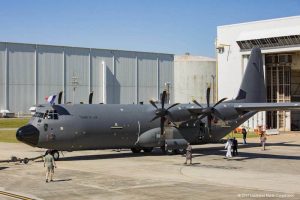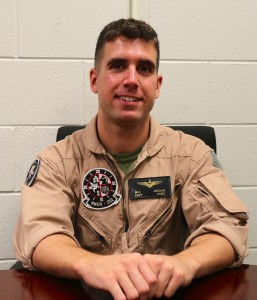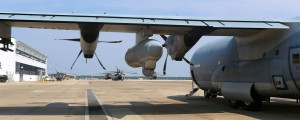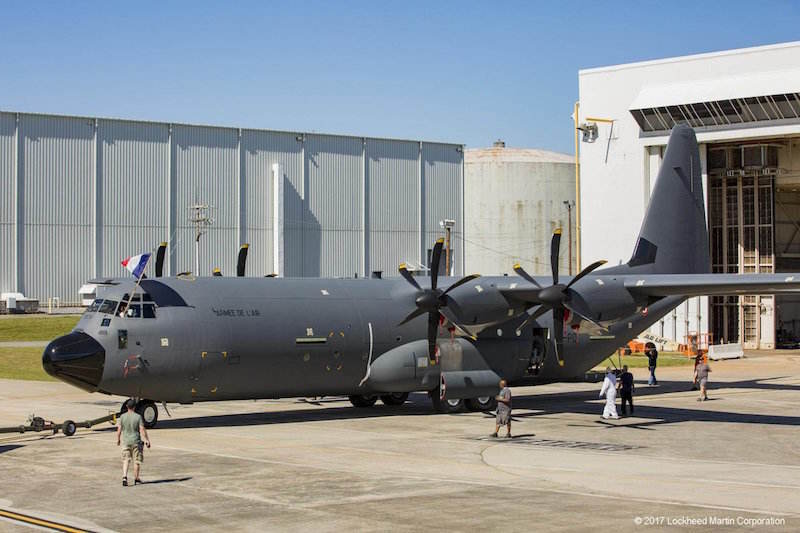2017-12-04 The C-130J is clearly a very flexible combat asset.
The Marines have expanded the envelope of their KC-130J as they have added Harvest Hawk several years ago and are adding communication and ISR integration capabilities which allow the aircraft to be a key element in the evolving digital interoperability of the Marine Corps force.
As the US Navy emphasizes distributed lethality, the USMC looks to enhance the capabilities of the Osprey and the C-130J to provide greater capability for the distributed force known as the MAGTF.
The US Air Force has brought its Js to Germany and are working the plane into their support efforts based in Germany as well.
The J first came to Ramstein in 2009 and became the first overseas base to get a C-130J flight simulator in 2015.
In an article by Jennifer Sean published on August 24, 2015 by Stars and Stripes, the coming of the flight simulator was described as follows.
It looks like an alien spacecraft your kid might want to take for a spin.
But this is no amusement park ride.
Ramstein is the first U.S. Air Force base overseas to get a C-130J Maintenance and Aircrew Training System — a fancy name for a flight simulator. It will be used to train aircrews that fly the C-130J Super Hercules from Ramstein and the maintainers who keep them ready to fly.
The 86th Airlift Wing hosted a ribbon-cutting ceremony Monday for the $25 million simulator and the new building that houses it, an $8 million military construction project.
The windowless simulator was open for visitors to take a peek inside, where Maj. Devon Cummings, an operations officer with the 86th Operational Support Squadron, practiced a “landing” on Ramstein’s runway. The physical features whizzing by on the video screen looked exactly as the pilot would see them approaching for landing, from the buildings along the airfield to the farm fields surrounding the base.
“Not bad. You’re qualified,” joked C-130J pilot Capt. Fred Backhus, who was leading Cummings through the drill.
Backhus said the simulator comes with a visual database system programmed to display most airfields to which the crews fly. “We just program it in: ‘We want to go here today.’ Boom, it’s there,” he said.
A recent video shows the C-130J operating from Ramstein.
C130J Operating at Ramstein Airbase from SldInfo.com on Vimeo.
The French are adding four C-130Js to their fleet and have taken their first aircraft this Fall.
France has placed orders for a total of four C130Js — two stretched C-130J-30 airlifters and two KC-130J tankers.
The aircraft are needed due to premature ageing of French Air Force C160 Transalls and an urgent requirement for additional medium tactical airlift capacity in operations.
The aircraft will be operated as part of a new joint Franco-German transport unit, to be based at the French AF base at Evreux.

According to an article by Helen Chachaty published on October 20, 2017:
The first of four C-130Js to equip the French Air Force rolled out October 20th. Painted in the colors of the Air Force, Lockheed Martin’s transport aircraft is expected to be delivered by the end of this year.
The rest of the fleet, which will ultimately consist of four aircraft, is expected to be delivered in the next two years, with versions with in-flight refueling capabilities (KC-130J) expected in 2019.
Announced in December 2015 as part of the update of the Military Programming Act, the order of four C-130Js aims to overcome the A400M’s capacity shortfalls in terms of refueling of helicopters, but also to increase the capabilities transportation of equipment and personnel.
In a story which we published in 2014, we looked at the flexibility of the KC-130J which certainly is a good reason for the French to include the aircraft in their force with the retirement of the Transall underway and with the demand for helicopter refueling in the French expeditionary force.
2014-07-31 By Robbin Laird
During my latest visit to Second Marine Air Wing, I focused upon the USMC evolution of its use of the KC-130J.
I spent a morning in the KC-130J simulator watching Marine pilots hone their skills and did so from the tanker seat in the aircraft.

After the simulation experience, I sat down with one of the pilots, Captain Michael Jordan, to talk about his experience working with the Harvest Hawk in Afghanistan.
The Captain is of the new generation of USMC pilots who have flown the KC-130J from the beginning and so the Harvest Hawk experience seems a “normal” evolution and simply preparing for the next transition, whereby the “mother ship” can handle data, C2 or ordinance dependent on the evolution of USMC concepts of operations.
The Harvest Hawk was first introduced into Afghanistan by 3rd MAW so the squadron went to the West Coast to learn their skills in preparation for their use of Harvest Hawk in Afghanistan in 2012.
We trained as Harvest Hawk co-pilots right before we deployed for Afghanistan last year.
And I would say that at least half of the hours we flew in Afghanistan starting in July 2013 through February of this year were Harvest Hawk missions.
After that I went to Spain and became part of the Special Purpose MAGTF.
He emphasized as well that it was different type of flying than on other KC-130J missions.
A lot of what you are doing is working in orbits, circling around targets, talking with people on the ground and managing the battlespace. 95% of what you are doing is flying, holding your orbit and then waiting for that 5% of the mission where you prepare to and then launch your ordinance.
And in flying the plane the operation from the cockpit is different as well.
With the Heads up Display you are flying the aircraft. Now you need to not just focus on just flying the aircraft and executing the mission but also work with the navigation radar to see where you are going and what you are doing within the battlespace.”

Question: What are the trade-offs necessary to operate a KC-130J as a Harvest Hawk?
Captain Jordan:
We lose the external tank on the left side as a sensor is placed on that tank.
We can not fuel from the tank.
This means that we reduce total fuel capacity.
A typical J would have a max fuel capacity of 60,000 pounds dependent upon fuel conditions.
With the Harvest Hawk configuration we can have a max fuel capacity of around 42,000 pounds. This reduces our time on station.
The Marine Corps is looking at an upgrade which would put the sensor on the front of the plane rather than the external tank and would recover the use of the tank.
The other aspect is that we lose the left side Aerial Refueling pod.
We have four hard points on the left side for the missiles; we can do refueling but with only one hose on the right hand side.
We can not have two houses serving the tanker mission.
Question: How are operations different from inside the aircraft to operate the Harvest Hawk mission?
Captain Jordan:
It is quite different.
In Harvest Hawk the pilot becomes more of a battle manager, while the co-pilot flies the plane.
In the back of the aircraft we have a different crew as well.
We generally have two officers in the back; a Fire Controls Officer sits in the right seat and operates the sensor to provide for target acquisition.
Typically, we have an assistant in the left seat to aid with the communications traffic and to assist the FCO.
Question: Where does Harvest Hawk go next?
Captain Jordan:
The entire Harvest Hawk experience highlights the utility of a “mother ship” in an air dominance environment.
There is no reason that we cannot take data from UAVs or the F-35s or the Harrier litening pods and be able to contribute to combat management or support to the ground commanders.


